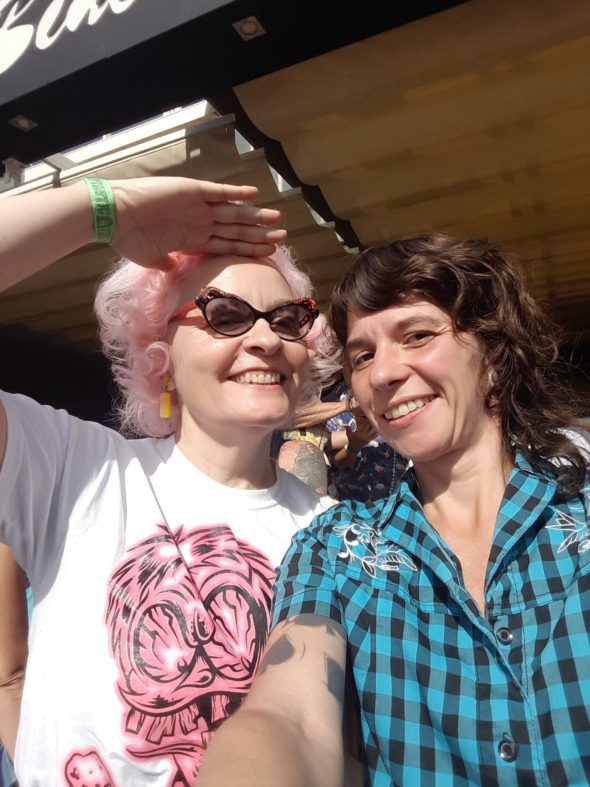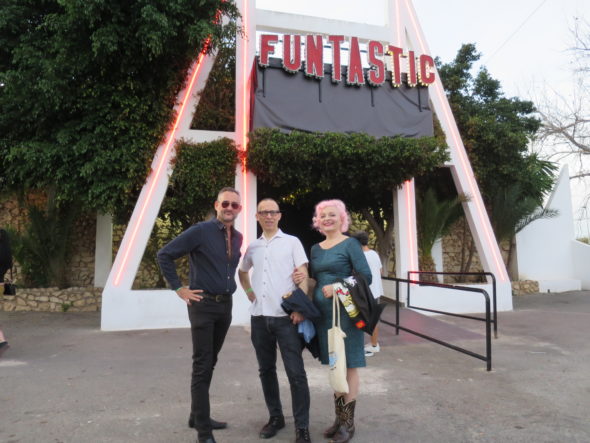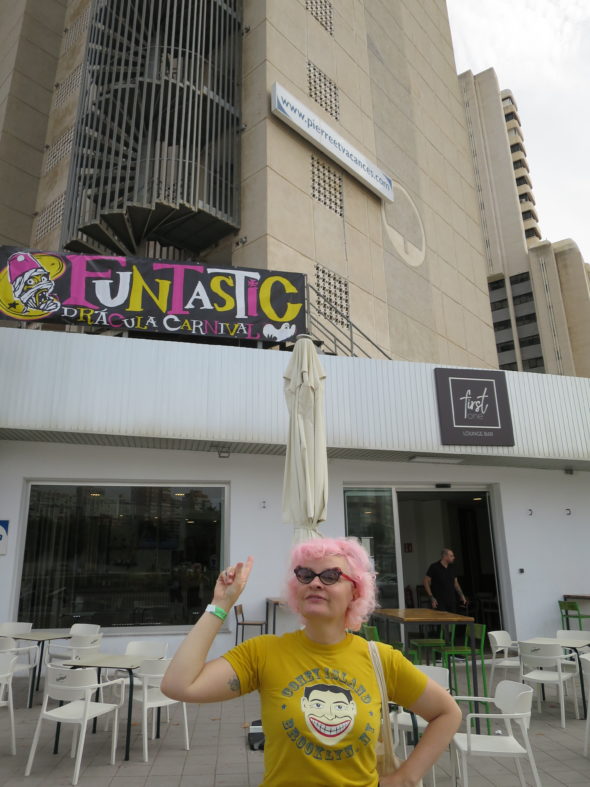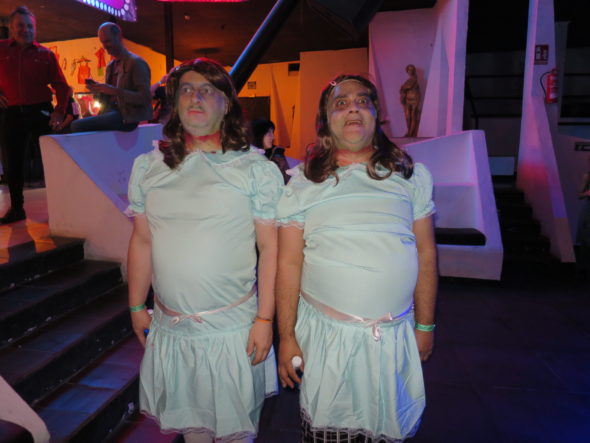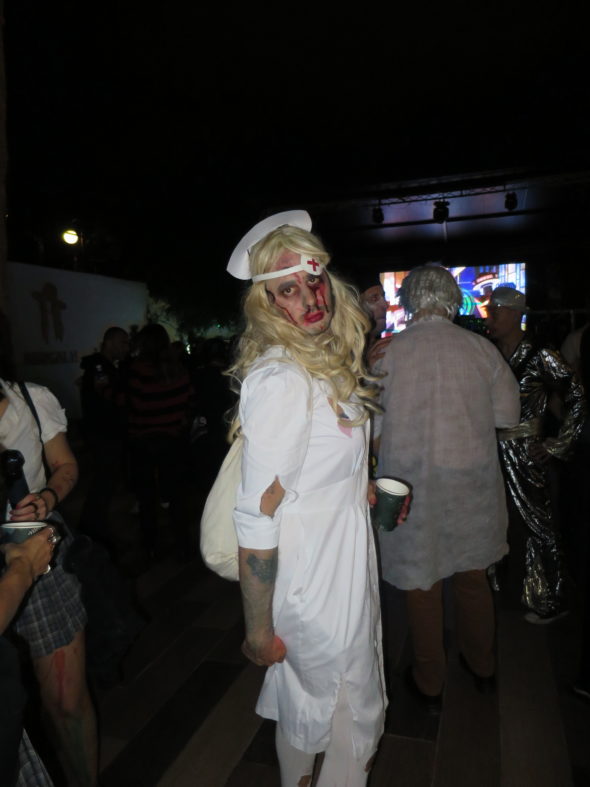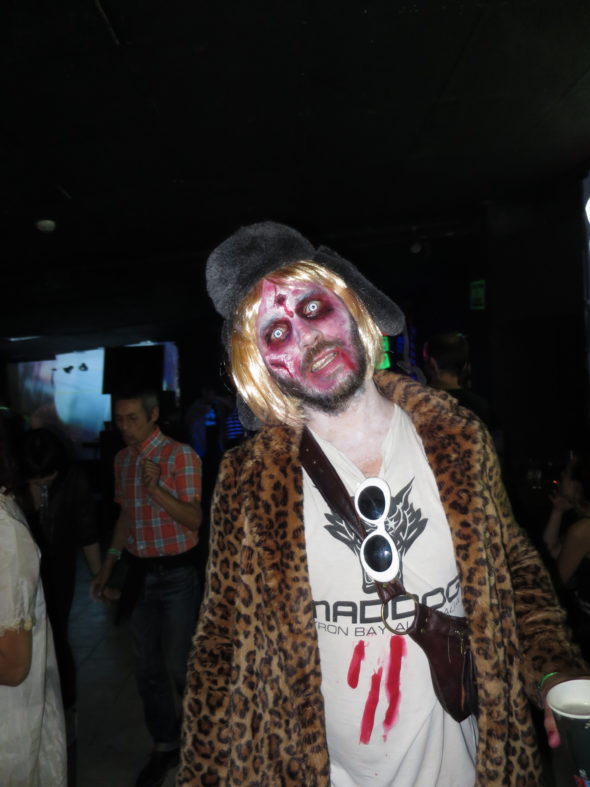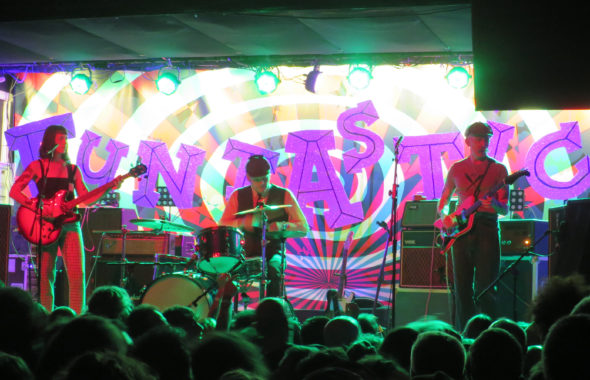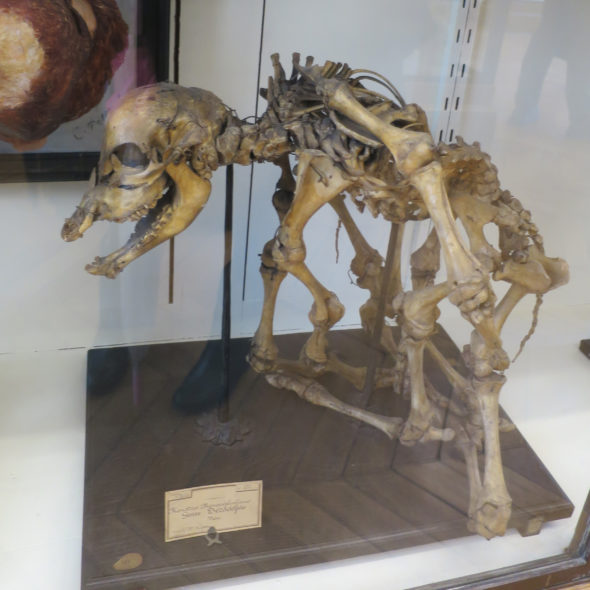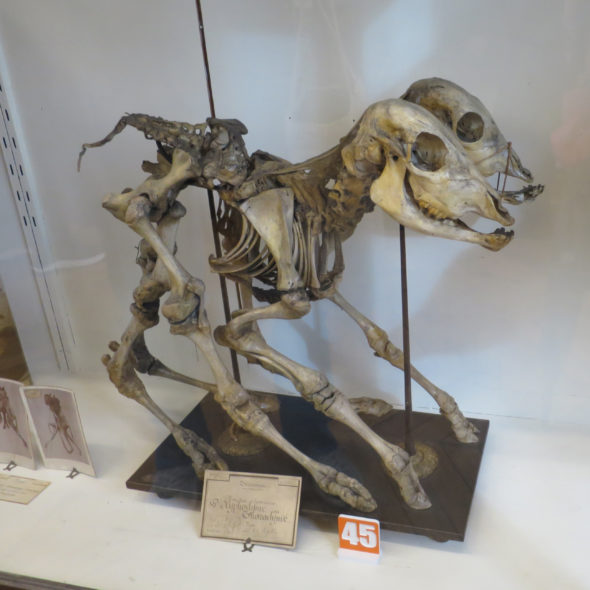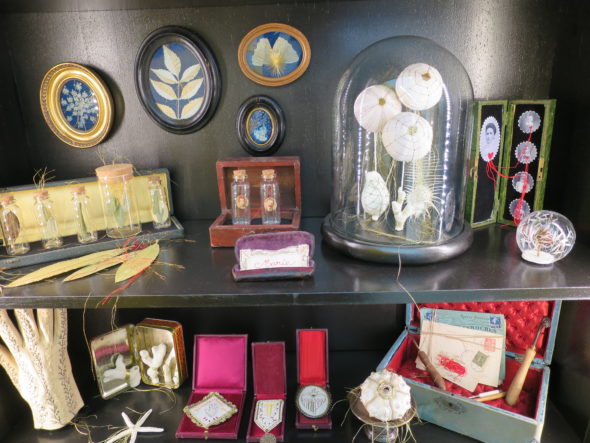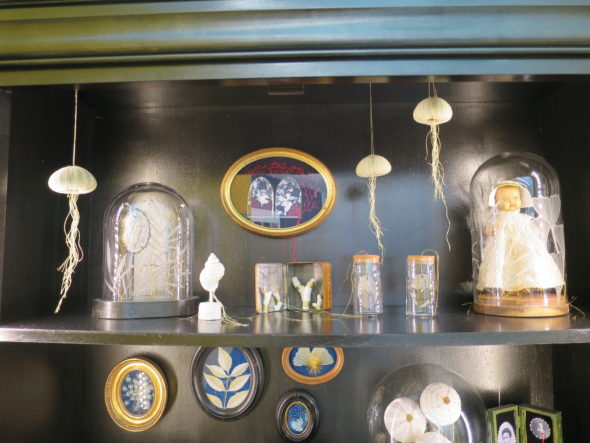Visit from Sara Purr
This October season, I got a studio visit from Seattle tattoo artist Sara Purr, and she gave me this little painting. We talked a lot about where tattooing is right now and esoteric stuff, especially Madame Blavatsky. It was such a nice visit. Go check out her Instagram: https://instagram.com/
AJ Ausina AKA AJ Dirtystein
Just before Halloween, AJ gave a lecture about Christianity and the Tarot, in the outskirts of Paris, with her very own new deck of Tarot cards. Ausina is a performance artist and practices magical tattooing.
AJ mentioned in her conference that Jesus and the french « je suis » (I AM) are homophones, which I had never heard before, but I am familier with the passage in Exodus: “And God said unto Moses, I Am That I Am: and he said, Thus shalt thou say unto the children of Israel, I Am hath sent me unto you” (Exodus 3:7–8, 13–14). I am familiar with a little tarot interpretation, and I loved hearing Ausina’s unique take on the deck. She was showing one of the cards in her tarot deck and talking about the hands and the heart, and hearing with the heart. Hearts are related to the cups in the tarot deck. A few things that I learned for the first time were these: She explained that the swords in the deck are the verbs and they are related to the head and the intellect. And that the wands were the creative side. Pentagrams are the structure and the roots, the material we can use.
I’m looking at my notes and I have written « ego separation » and the alchemical principle of « Solve et coagula » to dissolve and conjoin, I was very excited when I heard this as I’ve done a silkscreen print by the same name: Solve et coagula
She mentioned her newly discovered feminine strength that she has found in the bible. For her Marie says yes to life when she accepts the holy spirit’s plan for her to be the mother of God. She always sees that it is feminine figures that announce the coming of God or the presence of God. In her research she links the strong women of the bible with the women figures in the tarot.
I’ve got in my notes as ruling the head, Deborah the queen of swords, representing justice, the first female prophet, and somehow the symbol of the bee fits in there. I wish I could remember what she said. The queen of cups, which represents the heart, faith and love she sees as Moses’s sister Myriam. Judith is the queen of wands. The stomach is Rachel, mother of all Jews and queen of pentacles. I’ve got noted that the feet, the sabbath and sagesse are representing Lilith, queen of the sun and king Solomon is somehow linked with her.
Masculinity is represented by action.
The world card shows an androgynous figure the union of masculine and feminine, again she mentions coagula and the reuniting.
If you speak french AJ has made a course that you can follow on the tarot. Which you can subscribe to here: Tarot Formation
I really admire Dirtystein’s work as a performance artist. Check her out on Vimeo for her performances,
or Instagram: @a.j_ausina
The Funtastic Dracula Festival Benidorm, Spain
It was our 5th time back to Benidorm to go to the music festival there. It’s a great place to celebrate Halloween! Plus we always celebrate the beginning of our story together there.
Lecture at L’Ecole Vétérinaire by Morbid Anatomy
At the Honoré Fragonard and the Musée Fragonard de l’École vétérinaire de Maisons-Alfort
With Christophe Degueurce, Dean of the National Veterinary School of Alfort, Curator of the Fragonard Museum
Plus these lectures:
In Death so Full of Life: Fragonard’s Écorchés as Sculpture
Eleanor Crook, Sculptor and Medical Artist
French Wax Production: From its Birth in the 18th Century to its Rise in the 19th Century
Dr. Nathalie Latour, Art Historian and Wax Artist
The Paris Morgue as a Muse: Art and Inspiration Among the Anonymous Dead
Catriona Byers, Historian and Writer
Meaningful Anatomy from Amsterdam’s Museum Vrolik
Dr. Laurens de Rooy, Curator and Director of Amsterdam’s Museum
Eleanor Cook gave a great lecture filled with creativity and imagination. She explained that the cousin of the painter Fragonard (they lived together for a period) was an innovator of écorché preserved anatomy, of humans and animals by using resin and varnish, after the body had been dried out by alcohol. Insects usually destroyed preserved bodies, but the resin which comes from trees which protect themselves from insects, protect these works of art. She spoke of the cousins being a dark mirror to each other, the yin and yang. I also loved that Cook shared her fascination with the perfume family, with her fantasy that a film would be made showing the perfume being made downstairs and bodies floating in alcohol upstairs.
Cook spoke of Fragonard’s artistic choice of pose, facial expression which she sees as being parallel to painters of the same period. That he was able to convey intensity, and anger, with engorged viens and eyes popping. She called what he was able to do « consciousness melting down to the inanimate ». Perfect words coming from a sculptor herself.
Fragonard portrayed the biblical story of Samson with an asses jaw in a superhero rage, in righteous indignation. If you ever go to see this sculpture you see what see means.
She also mentions that all this was being made as the revolution approached and conferred that Fragonard saw « death galloping towards the aristocracy » in his sculpture of a man on a horse.
Nathalie Latour practices ceroplasty – sculpture in wax and she is also a specialist in the history of this art.
Mostly Doctor Latour made me want to visit all the places she mentioned.
She mentioned Specola, le Musée d’histoire naturelle et de zoologie de Florence and « Theater of death » by Gaetano Giulio Zumbo (1656 ?-1701) and the Palazzo Poggi in Bologne.
Apparently there’s an anatomy museum in Strasbourg with wax anatomy sculptures.
Latour mentioned that grave robbing was a very tempting way to procure bodies for dissection because the only bodies medical students could get were those prisoners condemned to death, mental hospital patients with no family. The lack of bodies was due to the taboo to desecrate the body after death and society’s attitude about death.
If you are in Paris and you like morbid anatomy you should check out the medical museum at the Hospital St Louis link: https://hopital-saintlouis.aphp.fr/le-musee-des-moulages-de-lhopital-de-saint-louis/ And the Museum of the History of Medicine link: https://u-paris.fr/musee-de-lhistoire-de-la-medecine/
Laws were finally passed in 1834 and 1850 which made bodies more available for medical research.
Catriona Byers @heymorguegirl spoke about the morgue as muse. There is an interplay btw violence, glamour, sexuality and death as change and renewal which is very inspiring to a lot of artists, (I can attest to that!) Byers gave Zola’s Therese Raquin as an example.
Byers talked about the taboo of dead bodies but also of the tabloid, sensationalist, voyeurism of the era. She explained that the public was encouraged to visit the morgue to identify bodies pulled from the river Seine. The morgue was listed as an interesting destination in tour guides of the era of the Universal Exposition.
Bryers mentioned the painting « La autopsia » 1890 by Enrique Simonet. A doctor doing an autopsy on a beautiful woman holding her heart. (I’ve got to check this out in person at the Prado Museum in Madrid)
The first photo ever taken was by Hippolyte Bayard « le noyé » of a drowned man 1839. I have in my notes performance protest art, gosh darn it, I wish I knew what it was in her lecture I wanted to note down! But it’s a mystery. (Edit) I spoke to Bryers and she explained to me: «So it was a self portrait photograph of a fictional suicide – his own – done in protest because Daguerre had been announced as the official inventor of photography. And Bayard had been competing for the title. And so he made a photograph of himself as a drowned man at the Paris morgue because he felt he had been abandoned by the establishment. And wrote an accompanying note explaining his rationale». Here is what he wrote on the back of the self-portrait: The corpse which you see here is that of M. Bayard, inventor of the process that has just been shown to you. As far as I know this indefatigable experimenter has been occupied for about three years with his discovery. The Government, which has been only too generous to Monsieur Daguerre, has said it can do nothing for Monsieur Bayard, and the poor wretch has drowned himself. Oh the vagaries of human life….! … He has been at the morgue for several days, and no-one has recognized or claimed him. Ladies and gentlemen, you’d better pass along for fear of offending your sense of smell, for as you can observe, the face and hands of the gentleman are beginning to decay.
Bryers mentioned the poem Apparent Failure by Robert Browning about suicides found in the river Seine waiting to be identified, she also mentioned President Harding’s sudden death and the refusal of his wife for an autopsy which led to rumours and scandal.
L’inconnue de la Seine 1885: a plaster cast of a beautiful young girl an enigmatic smile on her lips.
Byers talked about the anonymous body as a blank slate and the liminal space, the appeal of taboo, surrealism, death as the ultimate mystery, reality, identity, and political statement.
And then we got to tour the museum. It is a real gem that you should check out if you’re in Paris. Musée Fragonard de l’école vétérinaire
Exposition about Embroidery in Montreuil
Broder/Déborder at the Center Tignous d’art contemporain
Commissariat : Dominique Cabrera et Aude Cotelli.
Avec les artistes :
– Marine Ballestra
– Anaïs Beaulieu
– Nadja Berruyer
– Isabel Bisson-Mauduit
– Aude Cotelli
– Dominique Cabrera
– Fabienne Couderc
– Dominique Moreau
– Lili Rojas
– Valérie Rouzaud
– Sophie Wahnich
Scénographie : Raymond Sarti / Lumière : Lorenzo Marcolini
This small exposition was a cabinet of curiosities, just perfect for the month of October!
Halloween Flash
I offered up cool images for Halloween, but the holiday is not that popular in France. All of these images are still available.
New Halloween Illustration






